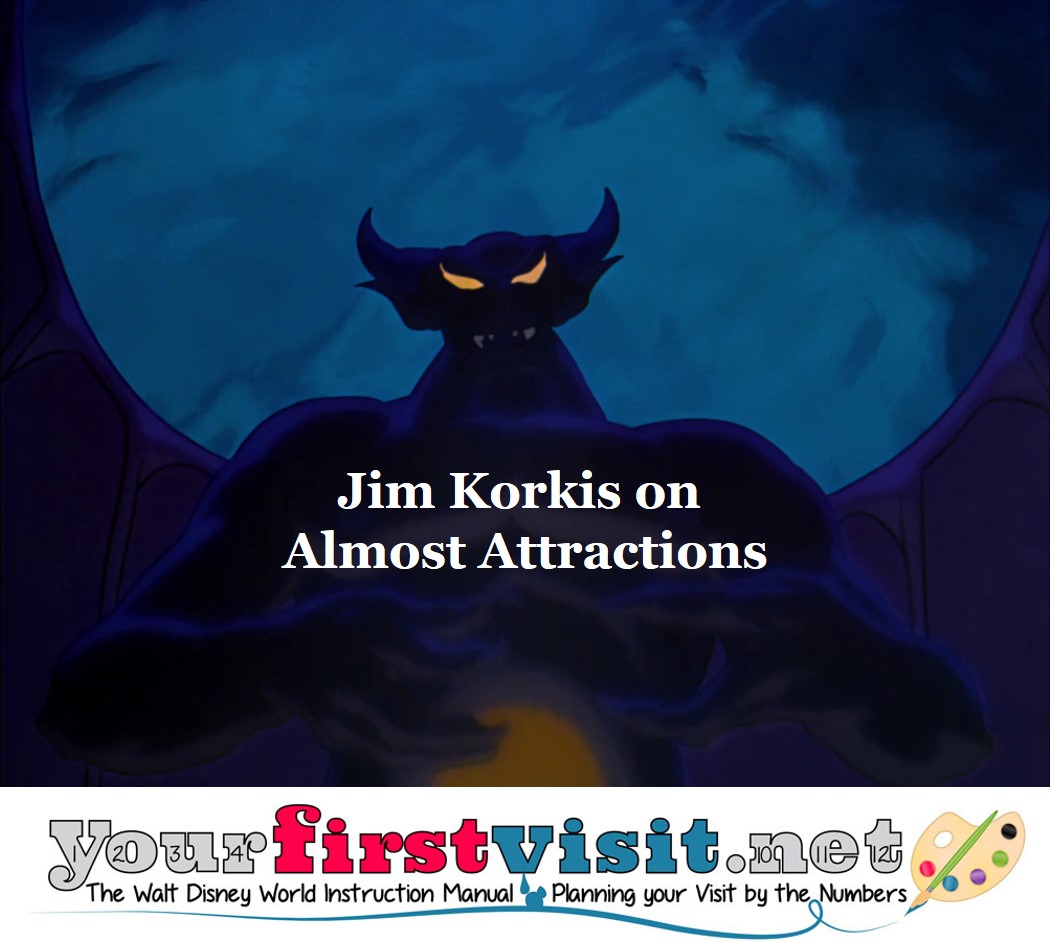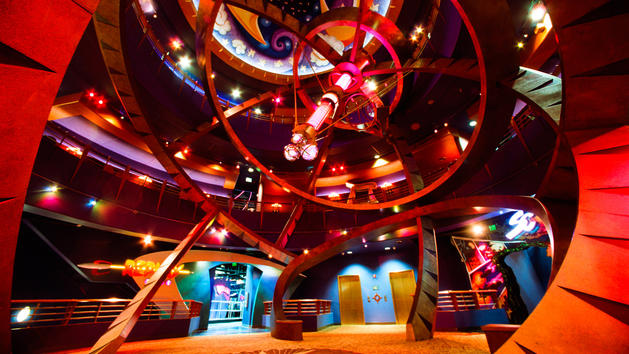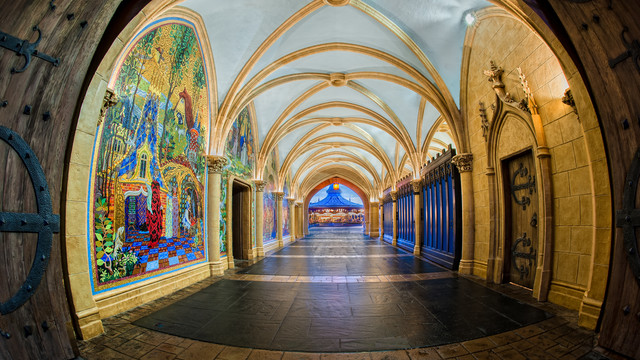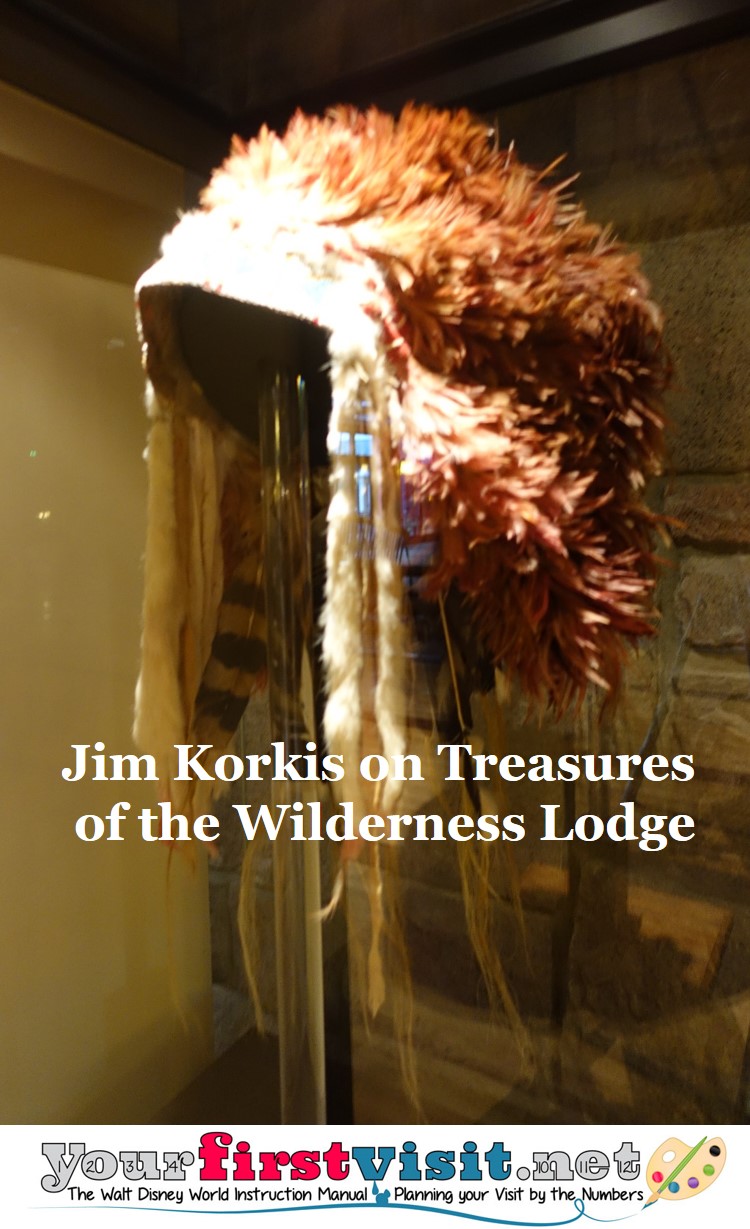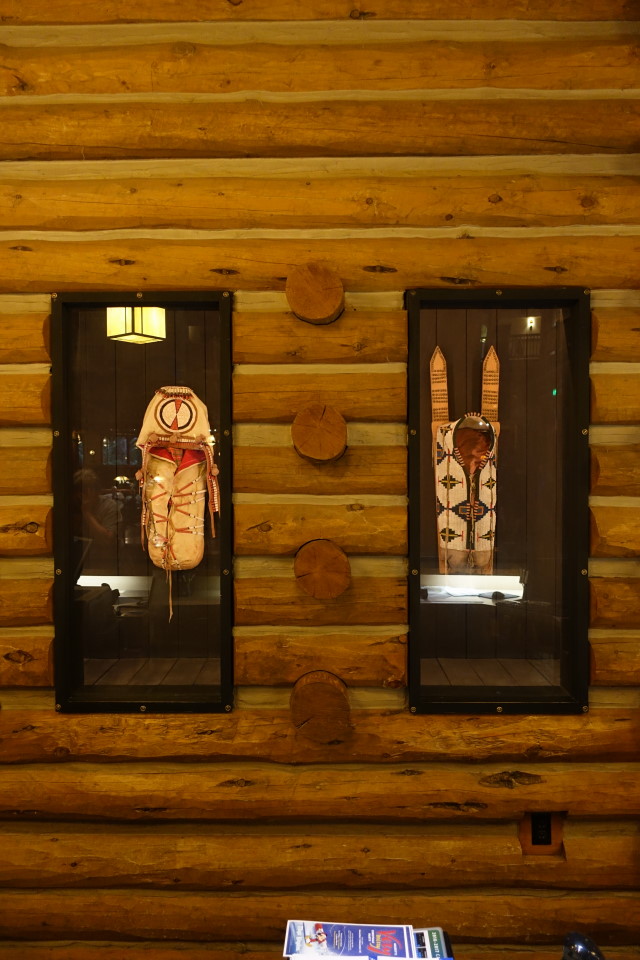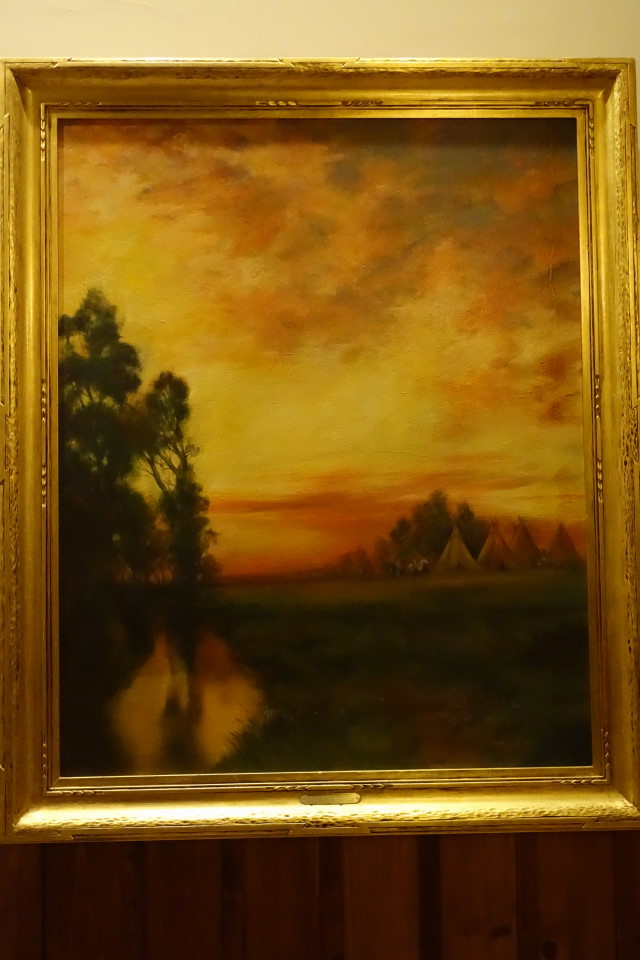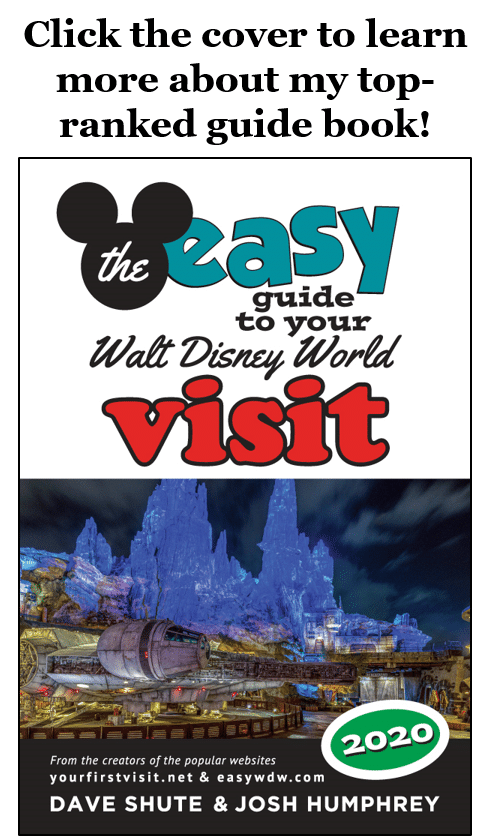Category — A Friday Visit with Jim Korkis
A Friday Visit with Jim Korkis: Attractions that Almost Were at Disney World
Welcome back to Fridays with Jim Korkis! Jim, the dean of Disney historians and author of Jim’s Gems in The easy Guide, writes about Walt Disney World history every Friday on yourfirstvisit.net.
By Jim Korkis
THINGS THAT ALMOST WERE AT DISNEY WORLD
The Excavator. The area at Disney’s Animal Kingdom now occupied by Chester and Hester’s Dino-rama featuring such carnival rides like TriceraTop Spin and Primeval Whirl was initially earmarked for a much more impressive thrill ride attraction.
Disney’s Animal Kingdom was intended to compete and outdo Busch Gardens Tampa with its live exotic animals and roller coasters. The original DAK Imagineers proposed a roller coaster similar to Big Thunder Mountain Railroad. It would be in an area that was supposedly a former sand and gravel pit with an enormous piece of leftover machinery called the Excavator.
The area had been abandoned when the Dino Institute bought the property after dinosaur bones were discovered and transformed the field offices of the former business into a dormitory and cafeteria for students.
Chester and Hester could no longer sell gas to the trucks and the workmen who operated at the site so they converted their business into a souvenir shop for tourists who were coming to see the dinosaur dig site.
The Excavator was meant to look like a series of ore cars used to haul up the sand and gravel from the bottom of the pit to dump trucks. The paleontology students who were working in the area had reconfigured the unsafe device that had fallen into disrepair to transport the dinosaur fossils they were finding.
The marketing publicity described it as “a rollicking coaster ride through a section of the dig supposedly too dangerous to enter”. At one point, the ride would have zoomed through the inside of a dinosaur skeleton.
It had been planned as an opening day attraction until budget cuts eliminated it but it appeared clearly on the original concept painting of the area. It was felt that the Countdown to Extinction (now DINOSAUR) attraction (since it re-used existing technology) would be easier and less expensive to build, yet still attract guests wanting a thrill ride.
Lagoon Islands at World Showcase. “There just wasn’t enough things for kids to do at World Showcase (when it first opened),” said Tony Baxter, former Senior Vice President, Creative Development, for Walt Disney Imagineering. “So one of the proposals was to use the islands in the middle of World Showcase’s lagoon as kind of a kids’ play area,” much like the Tom Sawyer Island in the Magic Kingdom but with an international theme.
That idea was scrapped when concerns about safety, transportation, capacity and budget were reviewed. An alternative concept of making the islands an exclusive “adults only” party area was considered and “which was very much the start of [Downtown Disney’s] Pleasure Island concept,” Baxter said, but was also rejected.
Dark Kingdom. The opening of Universal’s Islands of Adventure theme park in Orlando, Florida in 1999 and its appeal to an older teenage demographic prompted Disney to consider adding an “edgier” addition to its WDW parks. In the 1990s, Disney began formalizing a Disney Villains franchise that proved its popularity with the Villains in Vogue merchandise shop at Disney’s Hollywood Studios.
So it was proposed to add a new land at the back of the Magic Kingdom to be called the Dark Kingdom or Shadowlands. The icon for this new land would have been Maleficent’s castle.
Bald Mountain, a massive roller coaster ride inspired by Chernabog’s lair in the Disney’s animated feature film Fantasia (1940), was developed as well as a spinner ride similar to the Dumbo attraction that would have had Ursula the sea witch as the centerpiece and each of her octopus arms holding a ride vehicle. The concept was so intriguing that at one point Disney even considered expanding it into a fifth theme park.
* * * * *
Thanks, Jim! My own thoughts on a fifth Disney World theme park are here, sorta. And come back next Friday for more from Jim Korkis!
In the meantime, check out his books, including Secret Stories of Walt Disney World: Things You Never You Never Knew, which reprints much material first written for this site, and The Vault of Walt: Volume 4, and his contributions to The easy Guide to Your Walt Disney World Visit, all published by Theme Park Press.
Follow yourfirstvisit.net on Facebook or Google+ or Twitter or Pinterest!!
December 30, 2016 No Comments
A Friday Visit with Jim Korkis: Tributes to Lost Attractions
Welcome back to Fridays with Jim Korkis! Jim, the dean of Disney historians and author of Jim’s Gems in The easy Guide, writes about Walt Disney World history every Friday on yourfirstvisit.net.
By Jim Korkis
DISNEY WORLD ATTRACTION TRIBUTES
Many Imagineers are huge Disney fans as well and mourn the loss of an attraction or a removed venue as much as regular guests do. Sometimes, they will include little tributes to that former location in the new venue.
In the new AbracadaBar at the BoardWalk Resort is a framed copy of a newspaper on the wall that provides the back story of the magicians who mysteriously disappeared from there over seventy years earlier.
However in the lower right hand corner is an odd little news item:
- “Twin Sisters Advance in Beauty Pageant
- “The Sweets Invited to Seashore Finals
“The Boardwalk’s “sweetest” sisters have been invited to compete in the final round of the Miss Seashore beauty pageant. Their special talent? Serving confections with affection of course! Wish the ladies luck as they lead a celebratory rolling chair parade this Sunday on the boardwalk. At this pace, they may be on their way to becoming twin Miss America(s).”
The location used to be the home for a shop called Seashore Sweets supposedly run by two former Miss America contestants, the fictional Sweet sisters. The sign outside the shop proclaimed that it sold “confections with affection” and inside were all sorts of candy, ice cream and more.
The Barnstormer at Goofy’s Wise Acres Farm was a mini-roller coaster designed for children as a homemade “multiflex octo-plane” that was a popular attraction at Mickey’s Toontown Fair at the Magic Kingdom. A barnstormer was a term for a stunt pilot who traveled to rural areas to perform shows in a bi-plane.
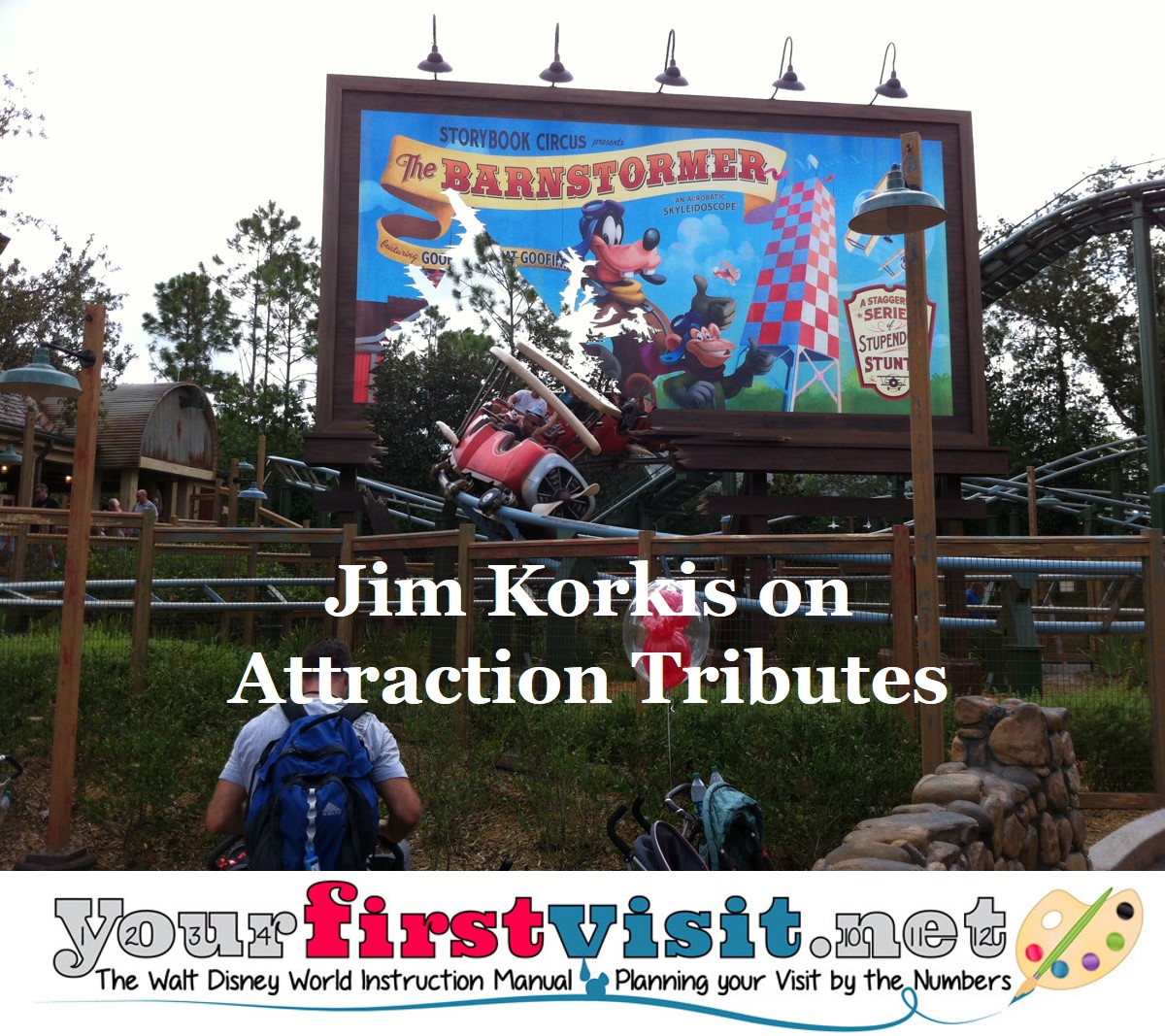
The back of the new sign for the attraction was designed to look as if the old sign had been taken apart and reformatted to make the new one.
In addition, the front of the sign states “An Acrobatic Skyleidoscope” which is a reference to the name of a daytime show that ran from 1985-1987 on the World Showcase Lagoon at Epcot. The small sea gulls in the top right corner of the new sign are meant to be a subtle tribute to the similar looking gulls found in the extinct Tomorrowland attraction If You Had Wings.
Under the Sea: Journey of the Little Mermaid attraction in the Magic Kingdom is on the spot where the former 20,000 Leagues Under the Sea attraction used to be located. In the queue line, on the left hand side is a “carving” in the faux rockwork of the silhouette of the famous Captain Nemo Nautilus submarine from the original attraction.
Before the original 20,000 Leagues Under the Sea attraction was removed, Imagineers bottled up some of the water from the attraction and kept it stored safely for nearly two decades when it was poured into the waters of the new attraction as part of the official opening.
The Many Adventures of Winnie the Pooh attraction in Fantasyland was originally the home for Mr. Toad’s Wild Ride. In the room meant to be Owl’s house is a framed picture on the left hand side of J. Thaddeus Toad handing over the deed of the land to Owl. On the floor to the right is a picture of Pooh greeting Moley, one of Toad’s closest friends.
In the pet cemetery at the exit of the Haunted Mansion attraction in Liberty Square in the upper part is a statue to Mr. Toad (actually one of the Big Fig merchandise items designed by artist Kevin Kidney).
Many other similar tributes are scattered throughout the vacation kingdom.
* * * * *
Thanks, Jim! And come back next Friday for more from Jim Korkis!
In the meantime, check out his books, including Secret Stories of Walt Disney World: Things You Never You Never Knew, which reprints much material first written for this site, and The Vault of Walt: Volume 4, and his contributions to The easy Guide to Your Walt Disney World Visit, all published by Theme Park Press.
Follow yourfirstvisit.net on Facebook or Google+ or Twitter or Pinterest!!
December 23, 2016 No Comments
A Friday Visit with Jim Korkis: DisneyQuest
Welcome back to Fridays with Jim Korkis! Jim, the dean of Disney historians and author of Jim’s Gems in The easy Guide, writes about Walt Disney World history every Friday on yourfirstvisit.net.
DISNEYQUEST
By Jim Korkis
The DisneyQuest program was designed to be a national series of multi-story, interactive “virtual” Disney theme parks for large urban areas that might have populations who could not frequently visit an actual Disney theme park.
To work out any challenges, the first five-story, one hundred thousand square foot DisneyQuest opened in the Downtown Disney West Side area on June 19, 1998 to take advantage of the participation of an already enthusiastically large audience to work out any challenges.
A second DisneyQuest opened in Chicago in 1999 but permanently closed on September 4, 2001 due to a number of factors including low attendance.
There were plans for twenty more similar venues, including ones in Philadelphia, in the Disneyland Resort in California as well as in Toronto, Canada, but none of them proceeded beyond the initial planning stages.
The idea started in late 1994 with vice president of new ventures Joe DiNunzio and Mike Lang of Corporate Strategic Planning.
“Since technology was arriving at a state where interactive storytelling and virtual environments were becoming possible, it seemed like a good time to push it a bit farther and develop a new kind of entertainment venue,” recalled senior producer and creative director Larry Gertz.
“The endeavor would have the environment and variety of a theme park, the interactivity of an arcade and the excitement of a thrill ride. And with the ability to create virtual environments and sets, the whole thing could be indoors and located in various cities, all over the world.”
To dispel the notion that it was merely an arcade to appeal to teenaged boys and young men, Disney hired five female show producers, three female engineers and had the lighting produced entirely by women.
“We produced fifteen different cutting edge attractions, all at once. And they all had to pass the Florida Ride Legislation review. We had to develop many technologies simultaneously that were all very different,” said project director Pete Rahill.
Disney Quest is divided into four zones of play:
- EXPLORE ZONE: The Virtual Jungle Cruise, Aladdin’s Magic Carpet Ride racing through Agrabah to release the Genie and the Pirates of the Caribbean: Battle for Buccaneer Gold.
- SCORE ZONE: A rescue mission on other planets in Invasion! An Alien Encounter and also Mighty Ducks Pinball Slam
- CREATE ZONE: The Living Easels to paint a live masterpiece. Create and ride a virtual rollercoaster at CyberSpace Mountain. Sid’s Create-A-Toy where guests could assemble and take home their own toy. Learn how to draw a Disney animated character at the Animation Academy. Create a CD by choosing from over 20 styles and 1000 vocals at the Radio Disney SongMaker.
- REPLAY ZONE: Buzz Lightyear’s AstroBlaster is a zany bumper car race. Mad Wave Motion Theater where you can ride a fantasy coaster or a high speed race car. The Dance Zone offers the latest dance video games and KidQuest is designed for kids ages 2 – 7.
Throughout the location, there are additional video games, pinball machines, and a Wonderland Café coffee and dessert location where guests could connect with the internet as well as a traditional Food Quest court with pizza, sandwiches, salads and other items.
When it first opened, the venue included other attractions like Hercules in the Underworld, the Cybrolator, The Cave of Wonders Slide, Treasure of the Incas and Magic Mirrors.
Redemption games were removed from the facility in January 2015.
In an era of smartphone apps, lifelike video games and other interactive attractions, DisneyQuest appeared too dated for many people. On June 30, 2015, Disney announced that the entire location would be closing in 2016 to make way for the NBA Experience. However, at Disney, plans are always changing and now it appears DisneyQuest will survive into 2017.
* * * * *
Thanks, Jim! And come back next Friday for more from Jim Korkis!
In the meantime, check out his books, including Secret Stories of Walt Disney World: Things You Never You Never Knew, which reprints much material first written for this site, and The Vault of Walt: Volume 4, and his contributions to The easy Guide to Your Walt Disney World Visit, all published by Theme Park Press.
Follow yourfirstvisit.net on Facebook or Google+ or Twitter or Pinterest!!
December 16, 2016 No Comments
A Friday Visit with Jim Korkis: Bill Evans
Welcome back to Fridays with Jim Korkis! Jim, the dean of Disney historians and author of Jim’s Gems in The easy Guide, writes about Walt Disney World history every Friday on yourfirstvisit.net.
THE PEOPLE WHO BUILT DISNEY WORLD: BILL EVANS
By Jim Korkis
In the spring of 1985, I got a chance to interview landscaper and Disney Legend Bill Evans about his work on the Disney theme parks.
In 1952, Bill and his brother Jack landscaped the grounds of Walt Disney’s Holmby Hills home. Walt then asked them in 1954 to landscape Disneyland. Jack passed away in 1958 of a heart attack.
Bill stayed on as a consultant, drawing landscape plans, installing materials and supervising maintenance of the Park. He was hired as the Director of Landscape Design and was responsible for the landscape design of Walt Disney World.
Although he officially retired in 1975, Bill consulted with Imagineering on the landscaping for every other Walt Disney theme park until his death. Today, his methods of plant propagation, plant relocation, and recycling are widely used everywhere.
To continue our celebration of WDW’s 45th Anniversary, here is a short excerpt from that interview I did with Bill:
“In Florida we had a perfectly miserable experience in the theme park area down there because of the Florida terrain. The site of Disney World is a big piece of real estate, almost fifty square miles. Walt wanted that kind of dimension in order to separate himself very thoroughly from the neon jungles that surrounded Disneyland. That was the plus side.
“The minus side was most of that site had an elevation of, I think, the fall in ten miles was only ten feet. There weren’t any hills on the property although they were described as hills by the local surveyors.
“As an example, I wanted to start a tree farm to start producing some of the material we needed. A surveyor said, ‘There is just the place for it. There is a hill over on the West Side that would be just fine. Not that many trees on it.’ He drove me over. There wasn’t a bit of road. It was all pasture land and swamp, and exceedingly poor pasture land at that. We finally arrived at the spot and he said, “What do you think of that? It’s a hill”.
“Boy, you could have fooled me. There was a place out there about maybe six or eight feet of freeboard before you ran into the water table.
“I’ll walk up there but catch me if I fall. I don’t want to roll all the way to the bottom.” (Laughs.)
“That’s where we put the tree farm.
“When we built the theme park, we had to lift the elevation of a hundred acres a maximum of 15 feet and a minimum of 10 feet. In order to get some freeboard to build the biggest basement in Florida, you had to raise the elevation. The process was to dig a 250 acre lagoon and the yield from that soil is what built that site.
“If you look at the soil profile in that part of Florida it is kind of like a Danish pastry. There is a skinny layer of sand on top and then there’s some peat muck, maybe something else and underneath all of that some blue clay and underneath that pink clay and then brown clay and gray clay. All the colors of the rainbow but all clay.
“When you move the earth you take off this layer and put that over somewhere else and this layer on top of that. All of this abominable soil. You could dig a hole in that and it would fill with water. You’d drain it and you had just as much water in there a week later.
“When we built Epcot, we were able to convince the engineers that no matter what it cost it would be a great economy to ignore that kind of source and go find a sandy source for soil. We have a very congenial environment for the landscaping at Epcot. No clay.”
* * * * *
Thanks, Jim! Bill Evans was named a Disney Legend in 1992.
And come back next Friday for more from Jim Korkis!
In the meantime, check out his books, including Secret Stories of Walt Disney World: Things You Never You Never Knew, which reprints much material first written for this site, and The Vault of Walt: Volume 4, and his contributions to The easy Guide to Your Walt Disney World Visit, all published by Theme Park Press.
Follow yourfirstvisit.net on Facebook or Google+ or Twitter or Pinterest!!
December 9, 2016 No Comments
A Friday Visit with Jim Korkis: The Murals of Cinderella Castle
Welcome back to Fridays with Jim Korkis! Jim, the dean of Disney historians and author of Jim’s Gems in The easy Guide, writes about Walt Disney World history every Friday on yourfirstvisit.net.
CINDERELLA CASTLE MURAL
By Jim Korkis
Five exquisite richly hued glass mosaic murals adorn the interior breezeway of Cinderella Castle. Each mural is in a Gothic archway fifteen feet high and ten feet wide.
The murals were designed by Disney artist Dorothea Redmond at WED Enterprises in California to tell the highlights of the story of Cinderella as adapted in the classic 1950 Disney animated feature film.
The transformation into a physical reality was given to world famed mosaicist Hanns-Joachim Scharff and his wife along with his daughter-in-law Monika.
Scharff studied art history at the University of Leipzig and was inspired and drawn to mosaics as a youth during a visit to Italy. He was an interrogator for the Nazis during World War II.
The Cinderella mural was actually Scharff’s second assignment for the Disney Company.
In 1966 for New Orleans Square in Disneyland, Scharff did thirty table tops in the Creole Café, the mosaic thresholds for the French Market, and work on two of the quaint specialty shops. The threshold designs were based on original art work from mid-19th century New Orleans.
Later, he and his daughter-in-law would do the mosaic entrance outside The Land pavilion at Epcot.
For the Cinderella murals, Scharff had Redmond’s drawings enlarged to full scale, divided into sections and then covered with fabric netting. With the help of his family, Scharff hand cut and shaped each piece of glass.
Hundreds of thousands of pieces of glass, both the smooth-faced Venetian glass and the rough-surfaced pieces broken from the Smalti (the Italian word for “glass cake”) traditionally used by Italian craftsmen were used. It eventually totaled over a million individual pieces and more than five hundred different colors.
Some pieces were as small as the head of a tack and those that were hand cut were shaped with a power grindstone to get the perfect fit. Bits of gold, silver and numerous “jewels” were also incorporated.
Using the patterns visible beneath the netting, the mosaic pieces were carefully glued by hand, one-by-one, face down onto the fabric which would later be easily removed once the panels were put in place.
Each section was transported to Florida and a crew of six craftsmen pressed the tiles firmly into the wet cement that had been applied to the walls. After the cement had dried and the fabric netting was removed, a coating of mortar was applied and worked into the gaps between the tiles to guarantee the artwork would not only stay in place but endured the constant touching of millions of guests.
From initial design to installation, it took over eighteen months.
There are five murals starting at the entrance. The first mural shows Lady Tremaine reading the invitation to the upcoming ball to her spoiled daughters Drizella and Anatasia. Poor Cinderella is sweeping the floor.
The main section of the second mural is above the doorway but a narrow portion of the mural also trails down on either side of the doorway. The scene depicts the Fairy Godmother magically creating a beautiful gown on Cinderella while the famous carriage is off to the right.
The third mural has Cinderella dashing away from the ball up a flight of stairs and leaving a glass slipper behind with her prince in pursuit.
The fourth mural is the scene where a seated Cinderella tries on the slipper. Standing behind her, Anatasia’s face is red with rage and Drizella’s face is green with envy. The footman with the slipper has the face of Herb Ryman, the Imagineer who designed the castle and the other royal courtier who is standing has the face of Imagineer John Hench.
The final mural shows Prince Charming carrying Cinderella aboard his white horse to live happily ever after.
* * * * *
Thanks, Jim! And come back next Friday for more from Jim Korkis!
In the meantime, check out his books, including Secret Stories of Walt Disney World: Things You Never You Never Knew, which reprints much material first written for this site, and The Vault of Walt: Volume 4, and his contributions to The easy Guide to Your Walt Disney World Visit, all published by Theme Park Press.
Follow yourfirstvisit.net on Facebook or Google+ or Twitter or Pinterest!!
December 2, 2016 No Comments
A Friday Visit with Jim Korkis: Treasures of the Wilderness Lodge
Welcome back to Fridays with Jim Korkis! Jim, the dean of Disney historians and author of Jim’s Gems in The easy Guide, writes about Walt Disney World history every Friday on yourfirstvisit.net.
TREASURES OF THE WILDERNESS LODGE
By Jim Korkis
November is the month that the annual Blessing of the Four Directions by Native Americans takes place in the lobby of Disney’s Wilderness Lodge.
Disney’s Wilderness Lodge celebrates not only American craftsmanship and the beauty of nature but also the people who lived in the great outdoors.
The lobby is a tribute to Native Americans. Whispering Canyon showcases cowboys as depicted on the backs of the chairs. Territory Lounge is the home to the explorers. Artist’s Point celebrates the painters who captured the images of the wilderness.
The eight story atrium lobby is so overwhelming that some Disney guests fail to appreciate the smaller details scattered throughout the space at eye-level that enrich the story.
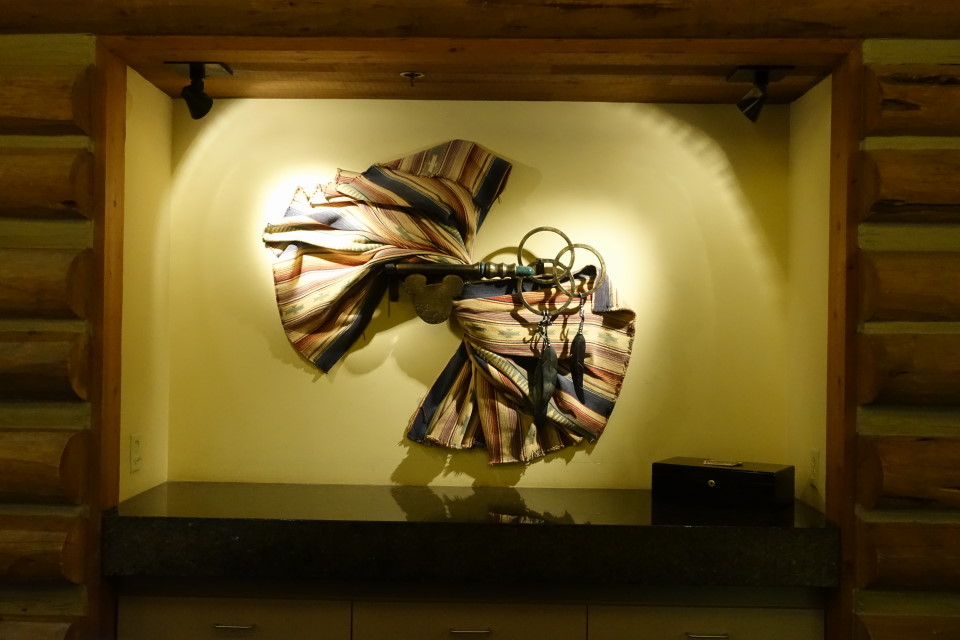
Also behind the Front desk are a beautiful collection of cradleboards. A cradleboard was a wooden frame and a soft skin pouch used for the protection of a baby or “papoose”.
The Spirit of America Discovery statue in the show at The American Adventure pavilion at Epcot has a Native American woman with a cradleboard on her back. The statue is meant to suggest the sixteen year old Sacagawea, the Native American woman who helped guide the Lewis and Clark expedition, along with her newborn baby.
Within the first few weeks after a baby was born, the mother would begin to lace the baby into the cradleboard so that it could be carried on the woman’s back or hooked onto a saddle. Left to right, the cradleboards behind the Front Desk represent the North American Indian tribes of Crow, Apache, Arapaho, Cheyenne, Ute, Kiowa, Navajo and Comanche.
A striking and unique garment is the Elk Tooth Dress located near the lobby elevators. It is made of red wool blanket or stroud cloth which was considered a desirable decorative fabric. This type of dress was typical of the Kiowa and Arapaho plains tribeswomen.
This particular dress was obviously the possession of a warrior’s wife since elk teeth are a great display of wealth. An elk only has two teeth and a dress might take hundreds of them. Most hunters saved the teeth as a memento of the hunt.
This rare dress, which has been determined to be from around 1875, was worn for special ceremonial occasions like a wedding.
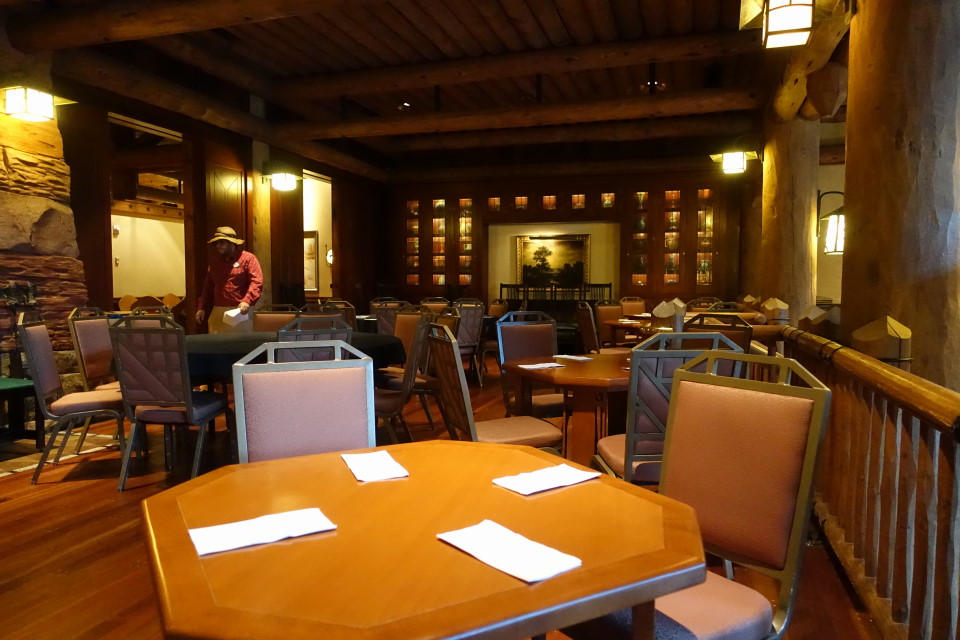
The pottery and ceramics that adorn the cabinet are authentic Arts and Crafts pieces from the Arts and Crafts Movement. They are a hundred years old. Mass production by machines were becoming more common so the Arts and Crafts Movement emphasized the appreciation for hand-made glass and pottery because they expressed the unique individuality of the particular artist.
Located to the left of the Whispering Canyon Café on the wall near the restrooms is a painting that is a reproduction of the work of Thomas Moran, an important panoramic Western landscape painter and illustrator. Moran is well known for his paintings of Yellowstone that helped inspire the creation of the area as a National Park in 1872.
Other interesting artifacts bring a sense of reality and history to the lobby and are worthy of a moment’s appreciation.
* * * * *
Thanks, Jim! And come back next Friday for more from Jim Korkis!
In the meantime, check out his books, including Secret Stories of Walt Disney World: Things You Never You Never Knew, which reprints much material first written for this site, and The Vault of Walt: Volume 4, and his contributions to The easy Guide to Your Walt Disney World Visit, all published by Theme Park Press.
Follow yourfirstvisit.net on Facebook or Google+ or Twitter or Pinterest!!
November 25, 2016 No Comments

